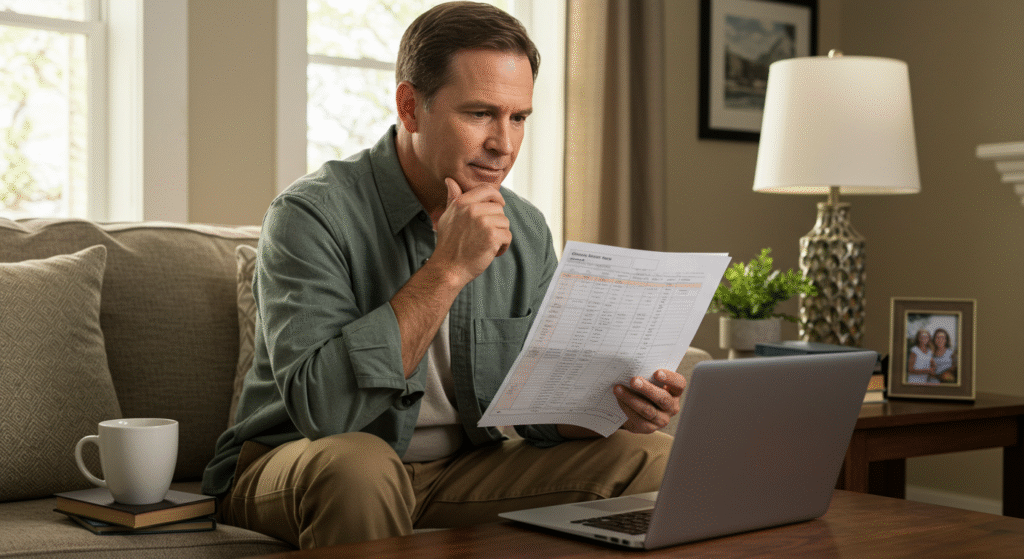Expenses shape both our personal budgets and business financial plans. Knowing the difference between fixed and variable expenses is key to managing money wisely. Fixed expenses stay the same each month, like rent or a car payment. Variable expenses, on the other hand, shift depending on usage or activity, such as groceries or utility bills.
This distinction matters because it affects how we budget, forecast, and adjust spending when life throws unexpected changes our way. By understanding fixed vs. variable expenses, you’ll learn how to plan smarter, reduce financial stress, and make better decisions whether you’re managing household funds or running a business. This article breaks down these two types of expenses clearly and offers practical tips to keep your finances more predictable and under control.
Defining Fixed Expenses

Before differentiating fixed expenses from variable ones, it’s important to clearly understand what fixed expenses are and how they behave. Fixed expenses are payments that stay the same in amount and frequency over a given period. They provide a consistent financial baseline, no matter what happens with your activity levels or production. Whether you’re running a household or managing a business, recognizing these expenses helps you create reliable budgets and plan accurately for the future.
Characteristics of Fixed Expenses
Fixed expenses have several defining traits that make them easy to identify:
- Consistency in Amount: You pay the same amount regularly. For example, rent is often a fixed monthly figure. This predictability removes surprises from your budget.
- Regular Payment Schedule: Fixed expenses usually occur on a monthly, quarterly, or yearly basis. This rhythm allows you to prepare in advance and smoothly organize your finances.
- Independence from Activity Levels: Fixed expenses do not change based on how much you produce or consume. Whether you run a small business or have a personal budget, these costs stay constant even if your income or output fluctuates.
- Contractual or Legal Basis: Many fixed expenses arise from contracts, leases, or long-term agreements that bind the payment terms for a specific duration.
- Essential for Operations: These expenses form the backbone of your financial commitments, covering costs necessary to keep your home or business running.
Understanding these characteristics is crucial. Fixed expenses create a predictable spending framework but also represent obligations you cannot easily avoid or reduce without renegotiation or strategic adjustments.
Examples of Fixed Expenses in Everyday Life and Business
Seeing these traits in real-world examples makes the concept clearer. Fixed expenses appear in both personal and business finances and play a vital role in monthly or annual planning.
In Everyday Life:
- Rent or Mortgage Payments: Usually the largest fixed cost, you pay the same rent or mortgage amount every month.
- Car Payments: Auto loans set a fixed monthly payment that remains constant throughout the loan term.
- Insurance Premiums: Health, home, car, and life insurance bills tend to have stable premiums, billed regularly.
- Subscription Services: Streaming platforms, gym memberships, or software subscriptions charge fixed fees monthly or annually.
- Property Taxes (if assessed yearly or quarterly): These may be fixed for a given year, even if paid in installments.
In Business:
- Office or Factory Rent: Companies rarely change rent based on output, keeping it consistent for a lease term.
- Salaries of Permanent Staff: Full-time employees usually receive fixed monthly salaries, regardless of sales performance.
- Insurance and Licenses: Business insurance and licensing fees are set amounts payable regularly.
- Loan Payments: Business loans require fixed repayments, contributing to predictable financial planning.
- Depreciation (non-cash expense): Though not an actual payment, depreciation is accounted for as a fixed cost on financial statements.
Each of these expenses contributes to steady cash outflows that must be accounted for regardless of how business or personal finances fluctuate. This stability can be reassuring but means you need a reliable income source to cover these costs without fail.
By knowing what fixed expenses look like and how they behave, you’re better prepared to build financial plans that accommodate your essential costs first before handling more flexible spending. This groundwork also helps when comparing fixed versus variable expenses, especially when adjusting budgets or analyzing profit margins.
Quick comparison box: Characteristics of Fixed Expenses
| Feature | Description | Why it Matters |
|---|---|---|
| Amount Consistency | Same payment amount each cycle | Easier budgeting |
| Payment Schedule | Regular (monthly, quarterly, yearly) | Predictable cash flow |
| Activity Independence | Not affected by production or usage levels | Provides financial stability |
| Contractual Nature | Often backed by agreements or laws | Hard to change without effort |
| Operational Necessity | Essential ongoing costs | Must be covered to keep operations |
Understanding fixed expenses is the foundation for managing your money wisely, whether paying your mortgage or sorting out business overhead. It helps set clear expectations for your financial commitments and makes it easier to identify areas where you might have room to save or adjust spending.
Understanding Variable Expenses

Variable expenses are a key part of any budget, whether you’re managing household finances or running a business. Unlike fixed expenses that stay stable over time, variable expenses shift based on activity levels, consumption, or other factors. Grasping how these costs behave gives you more control over your spending and helps you plan for months when bills are higher or lower.
I find that understanding variable expenses not only makes budgeting easier but also highlights areas where you can make adjustments when needed. These expenses often offer some flexibility, letting you tighten the purse strings or take advantage of opportunities to save. Let’s break down what makes variable expenses unique and look at some examples you’ll recognize.
Characteristics of Variable Expenses
Variable expenses have distinct features that set them apart from fixed costs:
- Fluctuate With Activity or Usage: These costs rise or fall depending on how much you consume or produce. For example, electricity bills vary with how much power you use.
- Unpredictable Amounts: Because they depend on factors like sales volume or personal habits, the expense amount can change from month to month, making them harder to pin down.
- Potential for Control and Adjustment: Unlike fixed costs, you can often influence variable expenses by changing behavior or operational practices. Turning off lights, buying fewer groceries, or negotiating supplier rates can lower these expenses.
- Direct Link to Operations or Lifestyle: Variable expenses reflect activities like production levels in a business or lifestyle choices in daily life.
- No Long-Term Commitment: These expenses aren’t usually locked in by contracts. That means you can reduce or increase them as circumstances demand.
Understanding these traits helps you see variable expenses as opportunities to adapt your spending. They represent the flexible side of your budget—where your actions have an immediate effect.
Examples of Variable Expenses in Daily Life and Business
Let’s look at concrete examples so you can connect these ideas to your own budget:
- Utility Bills: Heating, water, electricity, and gas bills depend on consumption. Using more or less directly impacts your monthly cost.
- Groceries and Dining Out: These expenses vary based on how often you shop or eat at restaurants.
- Transportation Costs: Fuel expenses, ride-share fares, or vehicle maintenance fluctuate depending on how much you travel.
- Raw Materials and Production Supplies: In business, costs for components or ingredients rise with production volume.
- Sales Commissions and Bonuses: These payments change relative to sales performance, rewarding higher output.
- Marketing and Shipping Fees: Advertising spend or shipping expenses flex depending on campaign size and order volume.
Imagine your grocery bill as a dial you can turn up or down. One week you might buy fresh produce and stock up; the next, you shop lightly. Businesses face this too as sales grow, so do their variable costs.
Since variable expenses reflect real-time decisions and demand, they make your budget more dynamic. Tracking and adjusting them regularly means you’re working with flexible financial levers instead of fixed anchors.
Common variable expenses in everyday life and business:
- Household Utilities (electricity, water, gas)
- Groceries and Food Delivery
- Entertainment and Leisure
- Raw Materials and Direct Labor
- Sales Commissions and Incentives
- Shipping and Packaging Costs
Knowing what counts as a variable expense allows you to prepare better. It also helps spot where you can make meaningful changes if you want to save money or improve profit margins.
Quick Tips for Managing Variable Expenses:
- Track monthly patterns to spot spikes or reductions.
- Set budgets with a buffer for unexpected changes.
- Look for ways to reduce consumption or waste.
- Negotiate with suppliers or service providers.
- Use technology tools to monitor usage in real-time.
By getting familiar with the characteristics and everyday examples of variable expenses, you can better plan your finances and make smarter decisions. This flexibility is what balances out the rigidity of fixed expenses and offers room to adapt when life or business shifts direction.
The Financial Impact of Fixed and Variable Expenses

When managing money, understanding how fixed and variable expenses affect your finances can transform your approach to budgeting and planning. Fixed expenses create a steady baseline in your budget, while variable expenses introduce flexibility and sometimes unpredictability. Knowing how to manage both helps you maintain control, avoid surprises, and plan for the future with confidence. Below, I share practical strategies for handling these expense types and explain how grasping their differences can sharpen your overall financial planning.
Budgeting Strategies for Fixed and Variable Expenses
Dealing with fixed and variable expenses requires a slightly different approach since they behave so differently. Here are some practical tips I apply to manage both effectively:
- Prioritize Fixed Expenses First
Since fixed expenses like rent, loan payments, or insurance premiums don’t change, I treat them as non-negotiable. These costs come first because missing them can cause long-term financial problems. List your fixed expenses to know exactly what you must cover every month. - Forecast Variable Expenses with Care
Variable expenses fluctuate, making them trickier to predict. I track these costs monthly to spot patterns—like how much utilities jump in summer or what weeks I spend more on groceries. Forecasting variable expenses with data helps avoid surprises and keeps me prepared. - Create a Buffer in Your Budget
I build some wiggle room for variable expenses to handle unexpected spikes. This way, when my utility bill or gas prices rise, I’m not scrambling to cover the difference. - Adjust Spending Habits Regularly
Variable expenses are where you can flex and save. When I notice I’m spending more on dining out or entertainment than planned, I consciously cut back or find less costly alternatives until my budget balances again. - Use Separate Tracking Tools
Keeping fixed and variable expenses in separate categories, whether in spreadsheets or budgeting apps, gives me clear insights each month. This separation helps highlight where adjustments are needed and where my money flows without effort.
Managing each type of expense on its own terms keeps my finances orderly and less stressful. Fixed expenses demand consistency while variable ones invite me to be flexible and proactive.
Using Expense Knowledge for Financial Planning
Knowing which expenses are fixed and which are variable doesn’t just help monthly budgets; it’s a powerful tool for broader financial planning and decision-making.
- Better Cash Flow Management
Fixed expenses create predictable cash outflows, so I know exactly how much income I must generate to meet those obligations. Variable expenses, on the other hand, allow me to respond to changes in income or circumstances by reducing discretionary spending if needed. - Risk Management
By separating expenses, I can assess how much financial risk I carry. High fixed expenses mean I need a steady income to avoid stress or debt. If fixed costs are large, I work to build an emergency fund that covers several months of those payments to protect against job loss or unexpected downturns. - Smarter Growth Decisions (For Businesses and Personal Goals)
Understanding how variable expenses scale with income or production informs pricing, investment, and expansion decisions. For example, if my business sales increase, variable costs rise accordingly, but fixed costs stay the same. This means more profit margins with growth. For personal finances, if my income grows, I can decide if I want to increase spending on variable costs or save more. - Improved Negotiation and Planning
Knowing which expenses are fixed helps me identify where renegotiation could happen—like refinancing loans or cutting subscriptions. For variable costs, I focus on efficiency—like reducing utility usage or shopping smarter—which can directly improve my bottom line. - Clearer Financial Reporting and Review
This separation simplifies reviewing where my money goes and helps identify trends fast. When variable costs spike unexpectedly, I can dig deeper to find causes and solutions without getting overwhelmed by all expenses mixed together.
Simply put, the clarity gained from separating fixed and variable expenses gives me confidence in making informed, flexible financial choices. It’s an essential step for anyone who wants to plan wisely, manage risks effectively, and optimize spending or investment according to changing circumstances.
Key Takeaways:
- Prioritize fixed expenses and forecast variable ones to maintain balance.
- Adjust habits to control variable expenses without affecting fixed costs.
- Use expense categories to assess financial risk and build safety nets.
- Apply expense knowledge to growth decisions and cost optimization.
This approach turned my budgeting from reactive to strategic and gave me peace of mind knowing what to expect and how to act when things change.
Modern Approaches to Managing Fixed and Variable Expenses

Managing fixed and variable expenses today looks different than it did a decade ago. The rapid development of technology and the changing preferences in cost structures offer new ways to keep financial control sharp and adaptable. Rather than sticking to traditional methods, many individuals and businesses now leverage digital tools and rethink how costs are structured to keep their cash flow healthier and more predictable. Let’s explore some of the most practical modern approaches anyone can use to stay on top of expenses.
Technology and Real-Time Expense Tracking
Expense management has moved from manual spreadsheets and paper receipts to automated, real-time digital systems. This shift makes a huge difference in how quickly and accurately you can monitor your costs, especially variable expenses which can change day-to-day.
Modern expense tracking tools enable you to:
- Capture data instantly using mobile apps that scan receipts, log transactions, or automatically sync with your bank or credit cards.
- Categorize expenses automatically so you don’t need to sort through each item by hand; the categorization respects whether costs are fixed or variable.
- Set alerts and budgets in real-time, keeping you informed when you are nearing limits or when unusual expenses show up.
- Generate reports and forecasts on demand to spot trends in spending and adjust your budget proactively.
For example, tools like Expensify, Mint, or QuickBooks provide dashboards that update your expense picture the moment something is purchased. This reduces surprises at the end of the month and helps you react to spending spikes faster. The ability to drill down on data anytime means your financial control shifts from reactive to proactive.
On a business level, more companies use integrated Enterprise Resource Planning (ERP) systems combined with AI-powered analytics. These track fixed expenses like salaries or leases alongside variable ones such as materials or commissions, giving leaders visibility into total costs and how they move with sales volume. This clarity drives smarter decisions about managing cash flow and scaling operations.
Flexible Cost Structures to Improve Cash Flow

Fixed costs can feel like chains, locking your budget in place even when revenues dip. That’s why modern management often involves finding ways to turn fixed expenses into variable ones, creating flexibility that better matches cash flow cycles.
Some effective tactics include:
- Leasing instead of buying equipment or property. Leasing turns what might be a large upfront fixed cost into regular payments that can be easier to adjust or negotiate when business conditions change.
- Outsourcing certain functions instead of maintaining fixed staff or infrastructure. For example, using freelance workers or contract services means you pay only when you need support, converting labor costs from fixed salaries to variable expenses.
- Subscription and pay-as-you-go models for software, utilities, or services let you scale usage and costs according to demand rather than committing to high fixed fees.
- Negotiating flexible vendor contracts that include volume discounts or adjustable terms according to usage or production levels.
These approaches can smooth out cash flow and raise financial resilience by preventing large fixed commitments from draining resources during slow periods. I’ve seen businesses transform their finances by switching to cloud-based services and outsourcing non-core activities, which freed up capital and lowered pressure from fixed monthly bills.
Adopting flexible cost structures takes some planning but offers great rewards. You keep essential capabilities without the burden of high fixed expenses, while maintaining the ability to ramp up when growth opportunities arise. This balance is often the difference between thriving and struggling in uncertain markets.
Quick Comparison: Traditional vs Modern Cost Structures
| Cost Type | Traditional Approach | Modern Flexible Approach |
|---|---|---|
| Equipment | Purchase outright (High fixed cost) | Leasing or renting (Variable payments) |
| Labor | Full-time staff only (Fixed salaries) | Mix of full-time + freelancers (Variable labor costs) |
| Software | One-time licenses (Fixed expense) | Subscription/pay-per-use (Variable expense) |
| Vendor Contracts | Long-term with fixed pricing | Flexible contracts, volume-based pricing |
Both technology-enabled tracking and flexible cost structures work hand in hand to put you in control of your finances. With better data and adaptable expenses, it’s easier to keep your budget balanced and aligned with actual needs. This approach makes the difference whether you’re managing household finances or running a business—not just surviving, but positioned to respond quickly to whatever comes next.
Conclusion
Understanding fixed vs. variable expenses is essential for building a solid financial foundation. Fixed expenses set the stage by providing consistency and predictability, while variable expenses offer the flexibility to adapt spending as circumstances change. Managing both effectively means you can control your budget, reduce financial stress, and make smarter decisions whether in your personal finances or business operations.
By recognizing the difference, you gain the power to prioritize essential costs, forecast spending more accurately, and spot opportunities to save or invest wisely. Keeping your fixed expenses in check and actively managing variable ones creates a healthier cash flow and strengthens your financial resilience over time.
I encourage you to apply these insights to your own financial life. Track your expenses, set clear budgets, and find the right balance between stability and flexibility. Smart management of fixed and variable expenses is a simple step with a big impact on how confidently you handle your money every day.




